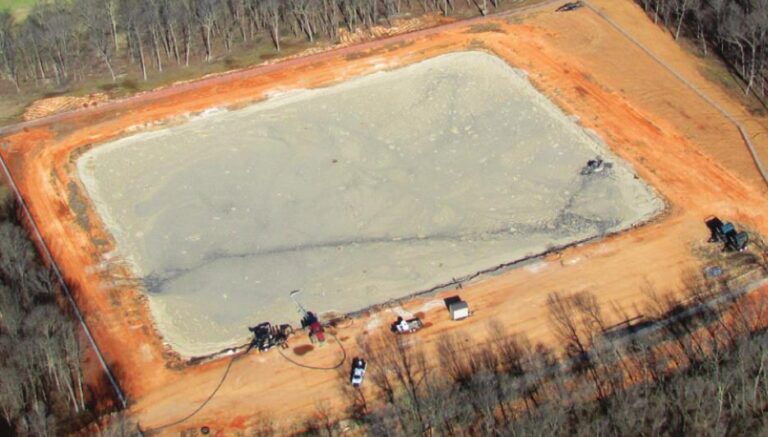Southwest Missouri: A dumpsite?


Caleb Wardlaw and his family raise vegetables and livestock on a homestead farm near a creek in Thomas Hollow. It’s the same creek he and his younger brothers grew up fishing and swimming in. Now, he fears for the quality of the water in that creek and in his private well because of unknown contents from the Denali lagoons which are being land-applied on properties above his. Sheila Harris/Special to the Cassville Democrat

An industrial waste lagoon constructed two miles southwest of Fairview by Denali Water Solutions is surrounded by trees. Its presence, however, can be smelled by neighbors, including residents in Fairview. Sheila Harris/Special to the Cassville Democrat


Sean Priest and his family live and raise cattle on land a 1/2 mile northeast of the lagoon near Fairview constructed by Denali Water Solutions, a national “organic residuals management” company with offices in Russellville, Ark. Sheila Harris/Special to the Cassville Democrat

An industrial waste lagoon located about four miles southwest of Stella, is one of two constructed in and near Newton County by Denali Water Solutions, a national “organic residuals management company,” with offices in Russellville, Arkansas. Sheila Harris/Special to the Cassville Democrat
During a time when fertilizer prices have almost tripled, Denali Water Solutions — a company in Arkansas that specializes in “organic residuals waste management” — has been offering free, land-applied fertilizer to farmers and ranchers in southwest Missouri.
The problem is, nobody is certain exactly what’s in the mix at any given time.
“I’m not sure whether the stuff they’re offering even is fertilizer,” said Caleb Wardlaw, who owns a farm alongside a tributary of Mike’s Creek in Thomas Hollow, near the Barry-McDonald County line.
Denali Water Solutions, a national firm with offices in Russellville, Ark., recently constructed two large lagoons in and near Newton County for the purpose of storing industrial and municipal waste. Those “residuals,” as Denali labels them on their website, refer to the refuse and offal from the facilities with whom Denali holds fertilizer distribution permits in the state of Missouri. According to the website of the Missouri Fertilizer Control Board, that number currently stands at 81. The majority of the entities with whom Denali contracts are located in states outside of Missouri. Thirty are in Arkansas. Recognizable names include Tyson Foods in multiple locations and the municipal waste facility for the city of Bentonville, Ark.
The first storage lagoon, with an approximate 2 million-gallon capacity, according to a recent report, was constructed in 2020, and is located two miles southwest of Fairview. The second one, similar in size, was constructed in the past year and is situated approximately five miles southwest of Stella. Neighbors were first alerted to the purpose for the lagoons by the “rank odor” emanating from them when the contents are stirred by deposits or withdrawals. It’s a smell that can’t be masked, even inside his house, said Sean Priest, who lives a half-mile northeast of the lagoon near Fairview.
“I’m more worried about the safety of my family’s drinking water, though,” said Priest, who sources his water from a private well.
Wardlaw, who holds a degree in Aquatic Resources and Marine Biology, echoes Priest’s sentiment.
The way the stuff they’re calling fertilizer smells, I don’t want it anywhere near my drinking water or in the creek near my house,” he said,.
Wardlaw put in a Sunshine Request with the Missouri Department of Natural Resources in February in an attempt to discover the contents of the lagoons. He was told two weeks ago that no matching results to his request were found.
Heather Peters, with the Watershed Protection Section of the Missouri Department of Natural Resources (DNR), says the general categories of ingredients in the Denali lagoons are “waste from meat and dairy processors, ingredients and preservative manufacturers, pet and animal food manufacturers, other food processors, and wastewater and/ or biosolids from a few municipalities.”
“Domestic wastewater treatment facility biosolids must meet all federal requirements,” she said.
Her words offer scant consolation to Wardlaw, since Peters also says land-application of the turbid mix from the Denali lagoons (biosolids or none) is not part of the DNR Watershed Protection Section’s jurisdiction — even in areas with impaired waterways.
While the Denali storage lagoons constructed in Newton County are a recent development in southwest Missouri, the land-application of their out-of-state contents has resulted in finger-pointing between regulatory agencies in Jefferson City.
“When a company like Denali, a non-point source, acquires a fertilizer distribution permit from the Missouri Fertilizer Control Board (MoFCB), with ingredients licensed by that board, they’re eligible for a fertilizer exemption from the DNR,” Peters said.
Peters said such exemptions extend to the storage, land-application and transporting of waste products (labeled as fertilizer) that companies may engage in after they receive distribution permits from the MoFCB.
Most farming operations, because of the diffuse nature of their fertilizer applications, are considered non-point sources of possible water pollution, Peters explained.
“Point sources,” on the other hand, she explained, have discharge points of possible water contaminants and are required to maintain discharge permits and meet the land-application regulations of the DNR. Examples include established chicken processing plants and established municipal wastewater facilities that operate in Missouri.
The established storage lagoons of Denali Water Solutions, now present in Missouri and containing out-of-state refuse, do not meet that DNR criteria, because the company has fertilizer distribution permits from the Missouri Fertilizer Control Board.
The Missouri Fertilizer Control Board is a 501c3 entity formed by legislative committee in 2016 to promote the fertilizer industry and oversee the administration of the Missouri Fertilizer Law. Before 2016, the state’s fertilizer program was under the auspices of the University of Missouri, said program director, Steve Taylor.
The Missouri Fertilizer Program, Taylor says, is called a “nature conservancy” and is funded by contributions, grants and the permit and tonnage fees that fertilizer distributors pay to transport fertilizer in Missouri.
When it comes to issuing fertilizer distribution permits to prospective distributors like Denali, Taylor says he feels like his hands are somewhat tied.
“The fertilizer law says that the presence of nitrogen, phosphorus or potash qualifies a substance as a fertilizer,” he said. “So, if one of those is present, we feel obligated to give a company a fertilizer distribution permit, provided that the other ingredients are not pollutants.”
After clean reports from test samples are presented, the ingredients themselves are licensed by the fertilizer board. A company then becomes eligible for a fertilizer exemption from the DNR, an exemption which includes the land-application of the ingredients, says Heather Peters.
When the nutrients themselves present a potential threat to waterways, the scenario becomes murky. Several waterways in the Elk River Watershed Basin — including Indian Creek, near where the Denali lagoons are located, and the confluence of Big and Little Sugar Creeks, near Caleb Wardlaw’s farm — were reported as “Nutrient Impaired” by the DNR as early as 2004. According to the report, the impairment by nitrogen and phosphorus was due, the DNR believed, to the proliferation of poultry farming in the area.
An excess amount of nutrients in soil, say scientists, can easily reach waterways through the myriad of fissures, sinkholes, caves and losing streams comprising southwest Missouri’s karst topography. There, they can cause an overgrowth of aquatic plant life and a deficit of oxygen in fish and wildlife. An excess of nitrogen (nitrates) in drinking water can adversely affect infants, pregnant women and otherwise vulnerable adults.
Peters says that “Better Management Practices” for the use of land are available to farms in Missouri that are classified as nonpoint sources of possible water pollution, but that compliance with those practices is voluntary.
“Even in areas of impaired waterways,” she added.
Arkansas, by comparison, is tightly regulated.
In 2003, Arkansas General Assembly labeled a large portion of northwest Arkansas as a “Nutrient Surplus Area,” due to the proliferation of poultry farming there. The Arkansas Natural Resources Commission took immediate steps to protect area waterways from the excess by tightening the regulations for fertilizer land application — including the disposition of organic materials such as animal waste and crop debris.
In spite of the role that the Missouri Fertilizer Control Board plays in the permitting and licensing of fertilizer ingredients and distributors, Steve Taylor believes, according to law, that the MoDNR has the final authority in water quality issues.
Heather Peters, however, says the Fertilizer Control Board is ultimately responsible for permitting the products which may end up in Missouri waterways, including in those known by the DNR to be impaired by nutrients.
“If visible run-off or discharge shows up in waterways, then we will investigate further,” Heather Peters said.
Wardlaw hopes it doesn’t come to that.
“I’m not saying anybody’s doing anything wrong,” he said. “I just want to catch a potential problem, before it becomes a bigger one.”
Meanwhile, the differences in regulatory practices between Missouri and Arkansas, coupled with the apparent impasse at the state level between the MoFCB and the DNR, make it appealing for Denali Water Solutions and other out-of-state companies to haul out-of-state waste into Missouri and land-apply it in the name of fertilizer, unhampered.
Chris Hammen, rural Purdy farmer and business owner, says he understands why area farmers might be accepting the offers of free fertilizer from Denali, although he hasn’t been offered any himself.
“Fertilizer prices have tripled in the last few months, which is making things difficult for farmers, so hopefully what’s being offered [by Denali] is a good deal and not harmful,” he said.
Hammen said he would want to get any free fertilizer checked out before he used it, though.
“I hope other farmers and ranchers feel the same way,” he said. “I don’t want to do anything that would harm the future production of my land.”
Heather Peters advises residents with concerns about their private well water to contact their local health departments.
Larry Bergner, administrator of the Newton County Health Department, says his office checks well water samples for two types of bacteria: coliform and e-coli; and for the presence of three metals: lead, cadmium and zinc.
According to Kimberly Scritchfield, the Environmental Public Health Specialist for the Barry County Health Department, her office offers several well-water test options, including a total coliform test for $20, which checks for e-coli; a nitrate test for $5; and a “new well” series for $30, which includes extensive testing for metals, chemicals and nitrates.
Larry Bergner recommends that residents with concerns [about water safety in regard to fertilizer application] contact their elected state representatives and senators to find out where regulatory gaps might exist, so they can be resolved.
“Nobody would want elements introduced into a water source that could potentially harm fish, wildlife and humans,” he said.
Denali Water Solutions did not respond to telephone calls and emails, nor did the separate owners of the private land where the Denali lagoons are situated.


